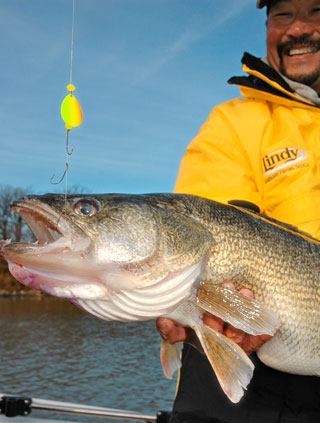Much like hybrid cars that run more efficiently on a combination of gasoline and electricity, spinner rigs are a marriage of two great ways to catch walleyes and these rigs are deadly anywhere walleyes are found. Spinners have the attraction of both artificial lures and live bait for a one-two punch that’s hard for walleyes to ignore any time water temps are above 50 degrees F.
 The natural scent and feel of juicy nightcrawlers have caught more fish over the years than most any other bait in history. The vibration and flash of spinners attract walleyes from a distance in clear water and prompt reaction strikes when water is dingy.
The natural scent and feel of juicy nightcrawlers have caught more fish over the years than most any other bait in history. The vibration and flash of spinners attract walleyes from a distance in clear water and prompt reaction strikes when water is dingy.
Spinner rigs also offer another key advantage – especially in larger bodies of water like the Great Lakes, where big brutes are vulnerable. You can cover large swatches of water with rigs and they’re more effective than many other presentations.
Another advantage? This technique is beautiful in its simplicity. A St. Croix Legend Tournament 7-foot TWC70MHM rod and a baitcasting reel like the slim-profile and light Ardent C400 make an awesome combination. TUF-Line’s DuraCast line is a hybrid, fused line which has the manageability of mono but the strength and no stretch of a super braid.
The spinner rigs themselves are usually 4 feet long on average. Lindy’s new spinner rigs and crawler harnesses feature realistic, holographic baitfish blades and super sharp #4 hooks. You can make the blade choice simple. Use smaller blades for smaller fish, say a number 3. Use bigger blades for bigger fish, like a number 4 or 5.
For colors, try metallic blades when the sun is out and/or the water is clear. Use florescent colors when the water is dirty or it’s cloudy. Colorado blades work for most situations. They turn well at slow speeds to produce both flash and vibration. Willowleaf and Indiana blades need to be trolled a little faster.
Rig it Right
Pick your own or the nearest bait shop will provide the finishing touch – a fat, juicy nightcrawler. Just make certain that the front hook goes through the worm’s nose then allow a little slack in the line and insert the second hook behind the collar. Dip the rig in the water beside the boat as you’re moving and make sure that the worm isn’t twisting before you let it down to the bottom.
How Much Weight?
We’ll try to keep your bottom-bouncer choice as simple as possible. Try to keep approximately a 45-degree angle to the water with your line, while moving from ¾ to 1.5 mph. Same if you’re drifting. A rule of thumb to rely on: 1 ounce for 5 to 15 feet, 2 ounces for 15 to 25 feet and 3 ounces for 25 to 35 feet.
Make sure you’re in the strike zone by dropping the bottom bouncer until you feel a “thunk” and see slack in the line. Thumb your spool and do not allow any line out for a couple of seconds as you are moving forward. Then lift your thumb up and free spool until your bottom bouncer hits the bottom again. Then turn the crank to lock in the spool. Keep dropping your rod back and feel the bottom every once in a while.
Location is Key
As with any presentation, location is the key. The great aspect of bottom bouncers is that they work in almost all situations. If walleyes are scattered over flats, you can drift with the wind or troll using planer boards to cover more ground. If walleyes are in the vegetation, precision troll the rigs along the weed line while hand-holding the rod. If you are trolling over short weeds, lower the rig to the bottom, reel up enough to clear the upper weed edge and go. Or trade the bottom bouncer for a bullet sinker, which passes through the green stuff more easily.
Snap Weights are an excellent weighting system to use for suspended walleyes. Let out 20 feet of line, clip on a weight of one size and let out 50 feet more and add a planer board. Do the same with other lines but use different weights to cover different points in the water column. Line counter reels help to return baits to the same depth time and again.
When trolling, use S-turns to cover breaks and to vary the speed of the spinners. The inside spinners move slower and the outside rigs move faster as the boat turns. Pay attention. If strikes come on one side or the other during a turn, walleyes may be showing a speed preference.
Moving slowly with a bow-mounted trolling motor, like MinnKota’s Terrova, allows you to seek out the little inside turns and small flat spots on the breaks that collect fish. Using mapping technology makes these fish-holding spots easy to find. Rather than having to fish the entire break, you can concentrate on just those areas that hold fish.
In late fall, try going with a tried-and-true Lindy Rig snell behind a bottom bouncer. Try the same locations on sharper breaks. Move a bit deeper than earlier in the year.
Hooksetting Tips
One final advantage of bottom bouncers – walleyes virtually hook themselves. If holding the rod, watch the rod tip for strikes. Move your arm back toward the fish until pressure from the fish on the other end causes the rod to bend or “load up.” You might even feel a strong head shake from a big fish. Then rear back and make a nice long, sweeping hook set.
Spinners and bottom bouncers – “The Deadliest Lure” can get you a big catch!










